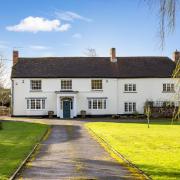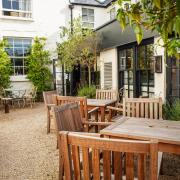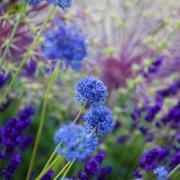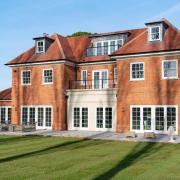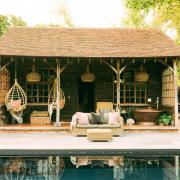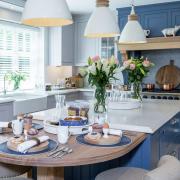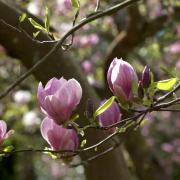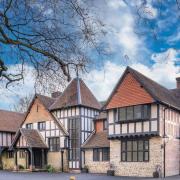Colour enhances our world and in the garden, it can bring areas to life; the different tones imbuing a range of emotions, from soothing to stimulating while bringing a sense of depth and perspective.
Never a static display, the effect changes in different weather and times of the day through the seasons. Variety, contrast and imagination are the keys to creating colour combinations in your garden.
While the sky and water are in a myriad of shades of blue, the colour is relatively rare and therefore highly prized in nature. Many scientists believe there is no true blue pigment in plants; the blue tones are brought about through the plants creating a variety of modifications and mixing of pigments, molecules and ions, along with reflected light.


The results can be stunning. Although most flowers described as blue are actually shades of violet or purple, there are some that are pure blues.
For the real thing some of the most glorious true blue choices include stately delphiniums, iridescent salvias, massed agapanthus and voluptuous hydrangeas.
Blue is even more rare in foliage than in flowers, with only a handful of tropical plants having blue foliage. As blue flowers are so coveted, growers may use the name ‘blue’ to increase sales, so you often need to take a look in person rather than rely on catalogues or online pictures.


Take for example roses; despite attempts so far there are no blue roses, and names such as ‘Rhapsody in Blue’ or ‘Blue for You’, are actually lavender in colour – an impressive achievement in itself as these tones weren’t created until the mid-20th century.
Blue extends the view as it recedes, so plant blue flowers at the end of a border to make it appear longer. It also adds depth to a small garden. Spring offers an array of bulbs to start the season with a splash or haze of blue. A sea of muscari interspersed with carmine tulips is an arresting sight. Scillas, squill, come in a range of blues, Ipheion make carpets of pastel blue stars, there are wonderful dwarf irises to discover, attractive spires of camassias, and don’t forget our native bluebells.
With a bit of creativity you can find options to add interest through the year, from soft pastels, through colours of the sky to dazzling electric blues.

Don’t forget the power of the paintbrush to transform furniture or walls, not to mention pots or sculptural possibilities.
Blue is a colour that is always popular and one that you are unlikely to tire of as it blends or contrasts so readily. For a fresh, clean combination that gives a sense of distance, echo delft china with blue and white blooms. Add some grey foliage to complete the effect.
Blue will stand out against other colours but take care with mixing blue-mauve tones with clear blue as it will throw off the colour. It’s much better to put blue with definite purple, mauve and pink for a pretty and harmonious combination.

Colour opposites orange and blue make a rich complementary combination that is sure to stand out and hot reds and yellow will jump out against cool blues.
Did you know that blue supresses appetite? So combine with high-impact yellow or orange near al fresco dining or barbecue areas to enhance your outdoor dining.
Rich, earthy colours will anchor blues. You may like to encourage relaxation,tranquillity and healing with blue tones, or use around a swimming pool or water feature to evoke the seaside.
Soft lemon, white and pale blue will add luminosity in shade and low light.
Feeling inspired to hunt out some blue options to plant this season? Look out for bulbs, perennials, annuals, vines and flowering shrubs. You may even like to have a go at growing the rarest of all the blue flowers – the Himalayan poppy.

HAMPSHIRE GARDENS TO INSPIRE

BRICK KILN COTTAGE Herriard, RG25 2PR and BLUEBELL WOOD/ BAVINS, Alton, GU34 5SX
Carpets of bluebells against unfurling lime green new foliage makes a tranquil scene to immerse yourself in. ngs.org.uk
HOUGHTON LODGE near Stockbridge, SO20 6LQ
In summer look out for the formal garden with a classic blue and white theme with stately delphiniums. houghtonlodge.co.uk
MECONOPSIS
Ben and Paddy Parmee of the Hampshire Alpine Garden Society open their garden on selected dates for members of the society, Plant Heritage, The Hardy Plant Society and for horticultural groups by arrangement. ben.parmee@alpinegardensociety.org
THE DOWN HOUSE Itchen Abbas, SO21 1AX
Pots of agapanthus on the terrace at the Thursday, August 1 NGS opening. ngs.org.uk
WHERE TO BUY BLUE
Hardy’s Cottage Garden Plants, Freefolk, RG28 7FA You’ll find a delightful range of options, including varieties of delphiniums, cornflowers and brunnera. hardysplants.co.uk
Fairweather’s Nursery, Brockenhurst, S0427YB Over 40 varieties of agapanthus. fairweathers.co.uk
Alpine Garden Society See website for local plant fairs. alpinegardensociety.net




